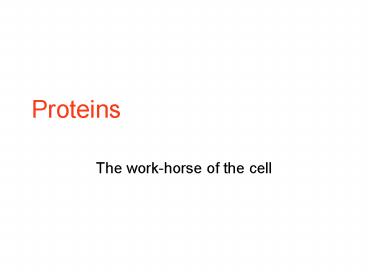Proteins PowerPoint PPT Presentation
1 / 19
Title: Proteins
1
Proteins
- The work-horse of the cell
2
Figure 6.14 The induced fit between an enzyme
and its substrate
3
Figure 6.15 The catalytic cycle of an enzyme
4
Table 5.1 An Overview of Protein Functions
5
Protein Structure
- Hierarchical levels of organization
- Primary
- based upon amino acid sequence
- Secondary
- based upon formation of hydrogen bonds between
the amin and carboxyl groups along the peptide
backbone - Tertiary
- based upon interactions of side chains
- Quaternary
- based upon interactions between multiple
subunits.
6
Amino Acids
- What are examples of amino acids?
- What do these have in common?
- How do they differ?
7
Figure 5.15 The 20 amino acids of proteins
nonpolar
8
Figure 5.15 The 20 amino acids of proteins
polar and electrically charged
9
Figure 5.16 Making a polypeptide chain
10
Figure 5.19 A single amino acid substitution in
a protein causes sickle-cell disease
11
Protein Structure
- Hierarchical levels of organization
- Primary
- based upon amino acid sequence
- Secondary
- based upon formation of hydrogen bonds between
the amin and carboxyl groups along the peptide
backbone - Tertiary
- based upon interactions of side chains
- Quaternary
- based upon interactions between multiple
subunits.
12
Figure 5.20 The secondary structure of a protein
13
Protein Structure
- Hierarchical levels of organization
- Primary
- based upon amino acid sequence
- Secondary
- based upon formation of hydrogen bonds between
the amin and carboxyl groups along the peptide
backbone - Tertiary
- based upon interactions of side chains
- Quaternary
- based upon interactions between multiple
subunits.
14
Figure 5.22 Examples of interactions
contributing to the tertiary structure of a
protein
15
Figure 5.17 Conformation of a protein, the
enzyme lysozyme
16
Protein Structure
- Hierarchical levels of organization
- Primary
- based upon amino acid sequence
- Secondary
- based upon formation of hydrogen bonds between
the amin and carboxyl groups along the peptide
backbone - Tertiary
- based upon interactions of side chains
- Quaternary
- based upon interactions between multiple
subunits.
17
Figure 5.23 The quaternary structure of proteins
18
Figure 5.24 Review the four levels of protein
structure
19
Why would a change in pH have a deleterious
effect on the function of a protein?

